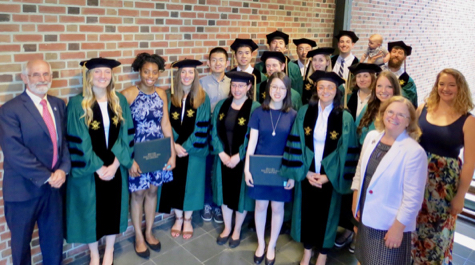Dean & Director Wells to retire in 2021
Wells has led institute to new heights despite significant challenges
Dr. John T. Wells of William & Mary’s Virginia Institute of Marine Science has announced his retirement as VIMS Dean and Director effective June 30, 2021. A nationwide search to fill the position will commence this fall.
Wells has led VIMS and its graduate School of Marine Science since 2004. Highlights of his 17-year tenure include continued progress towards a healthier and more sustainable Chesapeake Bay; bolstering of VIMS’ financial future through successful completion of the For the Bold fundraising campaign; and significant enhancements to research, educational, and advisory service programs and infrastructure at each of the institute’s three campuses—the 45-acre main campus in Gloucester Point, VIMS’ Eastern Shore Lab in Wachapreague, and the Kauffman Aquaculture Center in Topping, VA.
"John has led VIMS to new heights with wisdom and creativity,” says W&M President Katherine A. Rowe. “He did so during a tenure marked by major challenges and exciting opportunities. The financial collapse of 2008 and the current pandemic, but also the rapid transformation of marine sciences and research. The legacy of his time at the helm of VIMS is impressive: relationships built across the Commonwealth and nation; impactful solutions that support a healthy marine environment; research and public education cultivated in partnership with a generation of marine scientists. His leadership has benefitted William & Mary, the Chesapeake Bay, and Virginia’s coastal communities in lasting ways.”
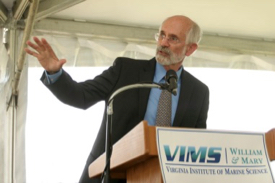
Wells arrived at VIMS following a 25-year career as a marine geologist on the faculty at UNC Chapel Hill and Louisiana State University and a 15-year overlapping stint as editor of Marine Geology. As VIMS Dean and Director, he oversees daily operations and strategic planning for one of the largest marine research and education centers in the U.S., with approximately 425 faculty, staff, and students, and an annual operating budget of $52 million. His leadership responsibilities extend to all aspects of VIMS’ three-part mission of research, education, and advisory service.
“Dean Wells’ contributions to VIMS and to marine science, most notably in the field of coastal marine geology, have enhanced our lives in immeasurable ways," says W&M Provost Peggy Agouris. "Think of him when you visit the Chesapeake Bay or catch sight of the state-of-the-art research vessel Virginia, another measure of his VIMS legacy. We are incredibly grateful for John’s dedication to scholarship, education, and service to our W&M community and the Commonwealth of Virginia.”
The Provost will be meeting with the VIMS community this week to discuss next steps and the search process.
Education
“John Wells’ stewardship of VIMS has been strikingly productive,” says W&M President Emeritus Taylor Reveley. “With abiding collegiality and civility, John has led wisely, and he has led strongly, making tough decisions when necessary and bold ones when opportunities arose. He will be sorely missed.”
Under Wells’ leadership, the School of Marine Science has established 37 privately funded Graduate Fellowships, whose endowments will help defray educational expenses and thus continue to help attract top-notch students from around the world. It also recently launched a new M.A. program designed to produce graduates with the knowledge, skills, and experience needed to translate, integrate, and apply marine science to issues of pressing societal concern.
Michael Halleran, who served with Wells for 10 years as W&M provost, says “John has been an exemplary leader who strengthened the VIMS faculty, improved student success, and transformed the physical plant. John keenly appreciated that VIMS was, as I would like to say, ‘special,’ and that in addition to being a critical part of William and Mary, it provides advisory service to the Commonwealth. John led VIMS in its complex mission with vision, integrity, and grace.”
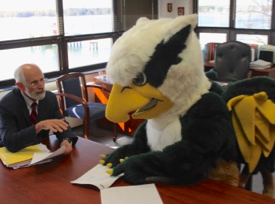 One indication of VIMS' academic success is that five VIMS graduate students have earned W&M’s Thatcher Prize for Excellence in Graduate and Professional Study during Wells’ tenure. Another 30 VIMS graduates have served as prestigious Knauss Marine Policy Fellows in legislative and executive offices in Washington, D.C.
One indication of VIMS' academic success is that five VIMS graduate students have earned W&M’s Thatcher Prize for Excellence in Graduate and Professional Study during Wells’ tenure. Another 30 VIMS graduates have served as prestigious Knauss Marine Policy Fellows in legislative and executive offices in Washington, D.C.
Dr. Linda Schaffner, Associate Dean of Academic Studies at VIMS, says “We continue to attract top students because John has remained fully committed to our mission of educating the next generation of leaders in marine science. He has been a strong supporter of all our education and outreach programs, working tirelessly to bring in the state and private support that allows our graduate program to stay competitive with top peer institutions.”
Research & Advisory Service
Wells’ leadership has also elevated VIMS’ role in advisory service, as mandated in 37 sections of the Code of Virginia. During his tenure, VIMS scientists have helped guide major decisions concerning Chesapeake Bay restoration, shoreline protection, blue crab harvesting, oyster aquaculture, offshore wind development, channel deepening, port expansion, management of ground- and surface-water supplies, and widening of both the Hampton Roads and Chesapeake Bay bridge tunnels.
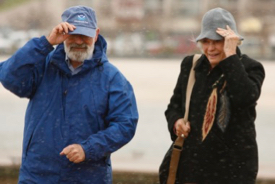 Dr. Mark Luckenbach, VIMS’ Associate Dean of Research and Advisory Services, says “John built very strong relationships with the General Assembly and several governors by regularly engaging and clearly articulating VIMS’ key role in addressing Virginia’s needs in marine resource management. We thus continue to have the public support required to conduct state-of-the-art research for the benefit of the Commonwealth and Nation.”
Dr. Mark Luckenbach, VIMS’ Associate Dean of Research and Advisory Services, says “John built very strong relationships with the General Assembly and several governors by regularly engaging and clearly articulating VIMS’ key role in addressing Virginia’s needs in marine resource management. We thus continue to have the public support required to conduct state-of-the-art research for the benefit of the Commonwealth and Nation.”
“The relationships he built proved invaluable in softening the blow of economic downturns and speeding our recovery,” adds Luckenbach. “His conviction that our advisory mission should be grounded in the best available science and delivered in an unbiased manner cemented the Institution’s reputation as an honest broker of environmental science.”
Accomplishments in research and advisory service during Wells’ tenure include the 2019 launch of VIMS’ new 93-foot flagship R/V Virginia, built with a $10 million investment from the Commonwealth. “No other vessel in its size class provides the sophisticated deck gear and geophysical and coring capabilities of the Virginia,” says Wells. “It’s got the flexibility to do almost anything on the water that our scientists might want to do, now or in the future.”
“The Virginia provides a much-improved platform for our fisheries surveys,” adds Luckenbach. “These are the foundation for recreational and commercial fisheries management not only in bay waters but for species up and down the East Coast.”
Building for people
Wells’ also led efforts at VIMS to conceive, plan, and fund several new state-of-the-art research and administrative buildings, transforming the VIMS campus. These include Andrews Hall, the Catlett Burruss Research and Education Laboratory, Davis Hall, the Facilities Management Building, the Seawater Research Laboratory, and the planned 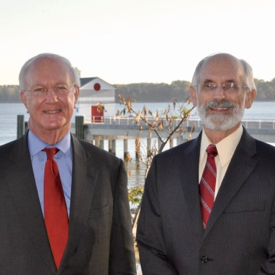 Acuff Center for Aquaculture, a state-of-the-art shellfish research hatchery to support Virginia’s rapidly expanding oyster aquaculture industry. VIMS’ Eastern Shore Laboratory, home to important work on clam aquaculture, bay scallop restoration, shark conservation, and coastal pollution and resiliency, has also enjoyed a major transformation, with a new seawater research lab, education building, and administrative offices.
Acuff Center for Aquaculture, a state-of-the-art shellfish research hatchery to support Virginia’s rapidly expanding oyster aquaculture industry. VIMS’ Eastern Shore Laboratory, home to important work on clam aquaculture, bay scallop restoration, shark conservation, and coastal pollution and resiliency, has also enjoyed a major transformation, with a new seawater research lab, education building, and administrative offices.
Wells’ success in upgrading campus facilities has been equaled if not surpassed by his achievements in filling 28 faculty positions vacated primarily through retirements, most held by professors with decades of experience. “Our hiring of a new cohort of world-class faculty is one of my single proudest accomplishments,” says Wells. “The skills and passion they bring to our research and teaching will certainly live on as my most important legacy.” Six VIMS faculty members have received the Outstanding Faculty Award from the State Council of Higher Education in Virginia during Wells’ tenure, while four have earned the Commonwealth’s Outstanding Scientist Award.
Wells has also supported greatly expanded efforts to communicate science with the public, including his funding for and participation in VIMS’ annual Marine Science Day open house, monthly After Hours lecture series, and public tours.
Building for the future
Wells’ legacy includes building a financial and research foundation with sufficient resiliency to meet future challenges. As part of W&M’s $1 billion For the Bold campaign, VIMS set a goal to raise $15 million by 2020. The institute surpassed that goal in 2015, and thanks to 6,100 generous donors, achieved unprecedented success, raising $26.5M when the campaign ended earlier this year. Future support will also come through the Dean & Director’s Innovation Fund, established in 2016 by the Joan and Morgan Massey Foundation and the Nunnally Charitable Trust. The income from this endowment supports research and education activities that foster innovation and economic productivity among faculty and students.
Says Wells, “Coupled with continued state and federal support, I trust that VIMS’ strengthened financial foundation will provide the flexibility and foresight needed to meet both existing and emerging challenges.” These include everything from sea-level rise to a more inclusive workplace.
Wells was instrumental in efforts to launch and sustain the Commonwealth Center for Recurrent Flooding Resiliency, a partnership established in 2016 by VIMS, W&M, and Old Dominion University to better infuse university-based expertise into the growing challenge of sea-level rise and recurrent flooding. “The Center positions VIMS and W&M as global players in resiliency and climate-change adaptation,” says Wells. “It uses our unique expertise in advisory service to help federal, state, and local governments join with higher education, business and industry to address one of our most pressing problems.”
Wells also established a Diversity and Inclusion Committee to increase representation of minority groups at VIMS. Founded on a “Principles of Community” document adopted in 2016, the D&I Committee reports directly to the Dean and Director and has wide latitude in helping to create and maintain the best possible environment in which diversity can thrive. Community-building activities at VIMS now serve as a model for other institutions.
“John can be credited with building a strong framework for managing VIMS into the future,” says Schaffner. “He has created a team of supporting administrators to work with him for effective management of VIMS, and on strategic planning and implementation that helps to ensure that VIMS will remain healthy moving ahead.”


